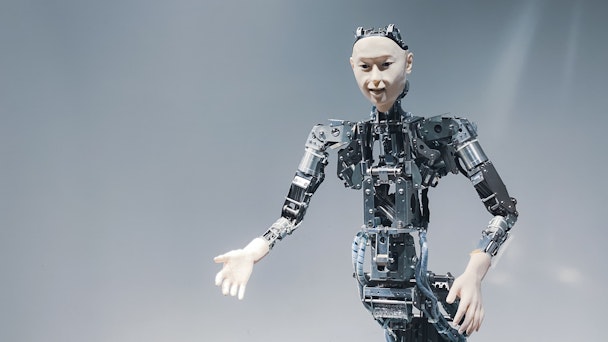How creative robots will save human artistry in the agency world
Steve Turnsek is chief executive at Otomo.io, AnalogFolk Group’s production automation solution. Here, he addresses concerns that creative robots will stifle creativity, arguing that they will instead unleash it.

Will creative robots help or hinder creativity? / Taiki Ishikawa via Unsplash
This is not an article about how artificial intelligence content-generation tools can create cool fun memes and images. This is about extending the power of human creativity by removing boundaries (time, cost, variation) from the creative and production process.
Remember the scene in Avatar where the bad guy climbs into a robot suit and starts shadowboxing? The robot suit makes him 50 feet tall, capable of knocking down trees with a single punch, and just as light on his feet as he is in real life. That’s what we want out of creative automation (bots), artificial intelligence (AI) and machine learning (ML).
What if, instead of replacing the artist with bots, AI or ML, we can use these technologies to enable the same artist to paint with a thousand brushes at one time, while painting 1,000 portraits at once, all perfectly? It may seem counterintuitive, but AI and ML together might just be the two factors that will ensure that great artistry in advertising is maintained, not lost.
Advertisement
Creative robots
The advertising world, at the dawn of the creative robot, faces a battle. Creatives must often choose: remain committed to artistically-crafted designs, or produce variations at break-neck speeds. The creative robot removes cost barriers associated with volume and variations, allowing creatives to remain dedicated to the integrity of their craft.
Removing this barrier has immediate, positive impacts on budgets and scale; you can make more ‘art’ without having to settle. The C-suite likes this.
But a greater impact occurs upstream in the more conceptual part of the process where creatives live. This impact allows creatives to think differently. It begs the question: ‘If time and cost no longer rule production decisions, what could I create?’
Ironically, it’s in this conceptual stage where creatives are most distrustful of software. Creatives worry that their artistry will be lost with poor and lifeless executions from software, or that their ideas will be replaced by AI.
There is genuine concern about unacceptable compromises to creativity due to the limitations of these tools. Many tools out there are not good, forcing compromise through templates. Creatively discriminating readers should avoid these like long Covid. There’s also the idea that AI threatens creatives’ very existence: why hire a creative when you can have Siri do it? As chief executive of a software company that creates content, I can tell you we are very far from that threat. And, as I’ll argue, bots can supercharge our human powers.
Advertisement
How do AI and ML help push creative boundaries?
Let’s start with a simple application, like playing with variations on a theme to push forward the quality of ideas. In the traditional world, limited by time and costs, brands and agencies can’t just create endless scamps and visuals. That’s no longer the case. Those machine-driven capabilities that deliver downstream efficiencies when used upstream can create a lightbox of ideas: countless variations and test runs.
With more complex creative applications such as programmatic technologies, machine-driven software can do more than just retrospectively assemble components based on programmatic triggers for optimized or personalized creative. During the creative process, it can greatly enhance the speed and ability to create complex routes or variations of a single creative idea, fine-tune them and see how they all relate back to the overarching campaign idea. All too often creatives are working blind; typically, volume and variation are too much to manage prior to launch.
Suggested newsletters for you
Will bots compromise creative?
Imagine a classical musician from the 1980s looking at a shoebox-sized CD player. Some of us can remember hearing words like, “that will never sound better than my bassoon in an orchestral hall.” Flash forward to Beats headphones and SoundCloud: creative explosions come from technology.
The problem is, creative teams get used to using a tool to produce individual, highly-polished, creative assets. A creative platform, however, is designed to offer variations of the main theme that work across applications and scenarios. Only software can do this effectively. The challenge is getting creatives to try new tools.
Brands love great creative agencies. But how many can deliver creative platform ‘matrix’ concepts for precision marketing, or even personalized marketing at the rich content level? Most of us think of personalized marketing as using a CRM to fill in a subject line. That’s not personalization or precision content; that’s buying the same boring corporate gift and slapping a sticker on it that reads, ‘just for you, my dear close friend, Blank.’
What now?
It’s more important than ever for creatives to understand how tools, data and new strategies impact artistry and its effectiveness. That’s where AI, ML and automation come into play.
By far the biggest impact is on creative. A 2017 Nielsen study showed that creative made up 47% of sales contribution through advertising elements. Of all the levers that go into precision marketing, creative dwarfs the rest.
Creativity is timeless. Tools can super-change creativity, but once everyone has the same tools (and they will) creativity is where agencies will always have the advantage. We must not fear automation, AI and ML software, but find the right tools to enhance our creative powers, remove barriers and create space for new amazing ideas.
Content by The Drum Network member:

AnalogFolk
Our mission is to use digital technology to make the analog world better and to also be an impactful agency of change for people, brands and society, in pursuit...
Find out more
